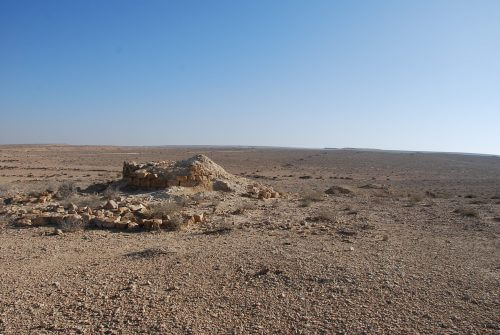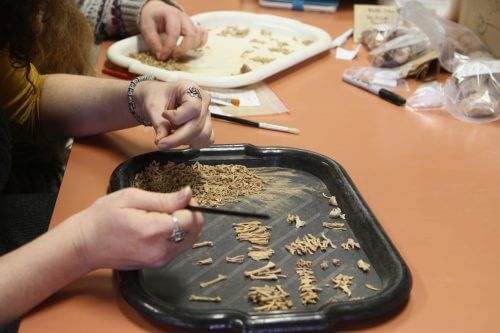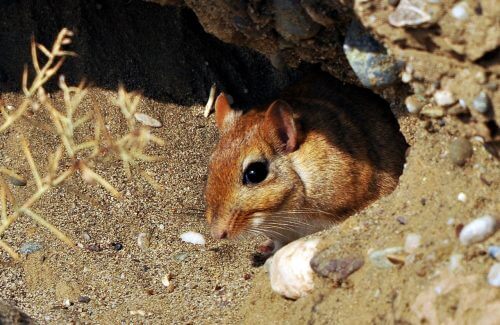Many bones of a common marion, the most common rodent in Israel that does not exceed 15 cm in length, that were discovered in the ancient agricultural fields of the Byzantines in the Negev, constitute the first biological evidence of the scope of agriculture that flourished in the northern Negev about 1,500 years ago and colored considerable parts of it green.

"Marion is widespread in Israel today throughout the Mediterranean region. In recent years, with the establishment of agriculture in the Negev, its area of distribution is expanding south. And here, in the Byzantine period, we find Marion bones in areas that today are arid and do not have the basic conditions necessary for their existence. This means that Byzantine agriculture was so developed that it changed the distribution of the variety of species in the desert," said Prof. Guy Bar Oz from the University of Haifa, who heads the project to examine the collapse of the Byzantine cities in the Negev.
During the Byzantine rule in the Land of Israel, in the third to seventh centuries AD, Byzantine settlements were established throughout the Negev - these settlements were abandoned sometime in the seventh century, with the beginning of the Islamic period. The archaeological evidence from the Negev, together with the historical writings tell about extensive agriculture in the Negev at that time. The archaeological excavations, where remains of terraces and irrigation and water storage plants were found, added evidence of the developed agriculture. However, to date, no biological evidence of this agricultural wealth has been found. The current archaeological-zoological study, which was conducted by research student Tal Farid together with Dr. Lior Weisbord, Dr. Yotam Teper and Prof. Guy Bar Oz from the Institute of Archeology at the University of Haifa, was able to find this evidence, using the remains of bones discovered in ancient pigeonholes that were built in the heart of the agricultural fields. The results of the study were published in the journal of the British Royal Society of Sciences.
From the data available today, the researchers know that the two species of rodents common in the Negev, the gerbil and the marion, are separated from each other according to the climate and terrain conditions: the gerbil can be found in arid areas, with less than 200 mm of rain, where the soil consists of shifting sand that is not covered by vegetation. Marion, on the other hand, is found in areas where there is over 200 mm of rain, the soil is moist and covered with vegetation - and naturally, most of the agriculture is also concentrated there.

As mentioned, the remains of the rodents were discovered by excavating a number of pigeon traps in the agricultural fields built around the rural communities of Shevta and Sa'don. The location of the pigeon traps shows the importance of the pigeon for the existence of Byzantine agriculture in the Negev. These were grown in order to utilize the manure that was used as an important fertilizer for fertilizing the loess fields of the Negev, which are soils poor in minerals. But the ones who left us the important findings, were not the pigeons, but the ones who settled on your return after the pigeons left. "In the part of the pigeon nests that we excavated, we identified the layer where the nests were destroyed and abandoned. Just above the layer of destruction, we began to find many bone remains of rodents," described Dr. Yotam Teper who managed the excavation. "Since signs of digestion were found on most of them, it immediately became clear to us that these remains are the remains of the meal of birds of prey - raptors or other birds - that took the place of the pigeons after the nest was destroyed," explained Dr. Weisbrod and Fried.
From an examination of the bones of the rodents, many bones of gerbils were found, but also many bones of marionettes. As mentioned, the sites where the researchers found the bones are all located in areas that currently have an average of less than 200 mm of rain, as Bata, is even found in an area of less than 100 mm of rain per year. The ground in all these areas is dry and mobile, so there should not be marionettes. "Our find indicates that Byzantine agriculture was so developed in the region that it completely changed the distribution of species in the Negev. This means that at that time, areas that are now arid were greener, more flourishing and more productive. The fact that we find the Marion bones in the period after the abandonment of the fields shows that the environmental change was so great that even after the abandonment the landscape took time to become arid. This shows the extent of the influence of Byzantine agriculture, which continued to influence nature long after it was abandoned." The researchers explain.

According to them, it is possible that at that time the climate in these areas was rainier and therefore enabled the foundation of the impressive agriculture, however, extraordinary technological capabilities were still required to store the water, to condition the fields and to create an agricultural living environment in the area. "This is the last time agriculture took place in the Negev until the renewal of Zionism and the settlement in the Negev with Ben-Gurion's vision. We continue to investigate the remains of the period with curiosity and excitement in anticipation of continuing to discover what were the factors and processes that led to the collapse of Byzantine society in the Negev. We still do not understand why the agricultural system they established failed. This is a topic that is very relevant even today, especially in an era of climate change and the need to adapt ourselves to the changing environmental conditions that lead to the spread of deserts in the world," Prof. Bar-Oz concluded.

7 תגובות
ח
This raises the question only for those who deny warming anyway.
There is no scientific debate as to whether there is warming, whether man is to blame for warming, or whether warming is dangerous.
There is only an irritating and harassing group, which denies the facts, and other facts such as the effectiveness of vaccines, the danger of "alternative medicine", the landing of man on the moon, Al-Qaeda's blame for 9/11 or the lie behind the "Matrilez".
Doesn't this raise the question, maybe global warming is not related to the industrial revolution?
Before 1500 there were indeed still no Muslims, but then the Negev was flourishing, as described here.
The Muslims came a few years after that and probably wiped out everything.
There is no connection to the Middle Ages, which began a few hundred years later.
Spain should not be compared to the Negev, because Spain is not a desert, as we know, but a fertile land, therefore it is much easier to have a developed agriculture there.
Here there were probably unique methods of the Nabateans and Byzantines, which were eliminated by the conquerors, who could only be Muslims.
It is very easy to wave the flag of racism. And interestingly, the "victims" are always the Muslims, who also happen to be responsible for most of the attacks and hazards...
I wish the counter would flourish again like in ancient times and even more, thanks to the Jews, of course, who are always building and flourishing...
It is a fact that in the last 1500 years when the Negev was ruled by Turks and Egyptians and Bedouins and all kinds of other Muslims, there was nothing but a wasteland...
This is indeed true and not racism!!!
The commenter AdamAdom proved both ignorance and stupidity and a misunderstanding of the site where he is commenting. Anyone who has visited Granada, Istanbul or Samarkand or at least seen photos from the aforementioned places immediately understands what is being said. The above should learn a little about the history of the Middle Ages, especially the parts related to the issues of culture, science and education.
In general, it is worth remembering that it is allowed to be racist just as it is allowed to be anti-Semitic, only that it usually does not add respect to such blood.
Adam Red
Before 1500 there were no Muslims.
It is stated in the article that everything was abandoned at once. This system failed because the Muslims conquered the area. Since, like today, they are mostly able to destroy and less to create, then even at that time, after their conquest, no one cultivated the fields.
It means that for 1500 years the Negev was desolate